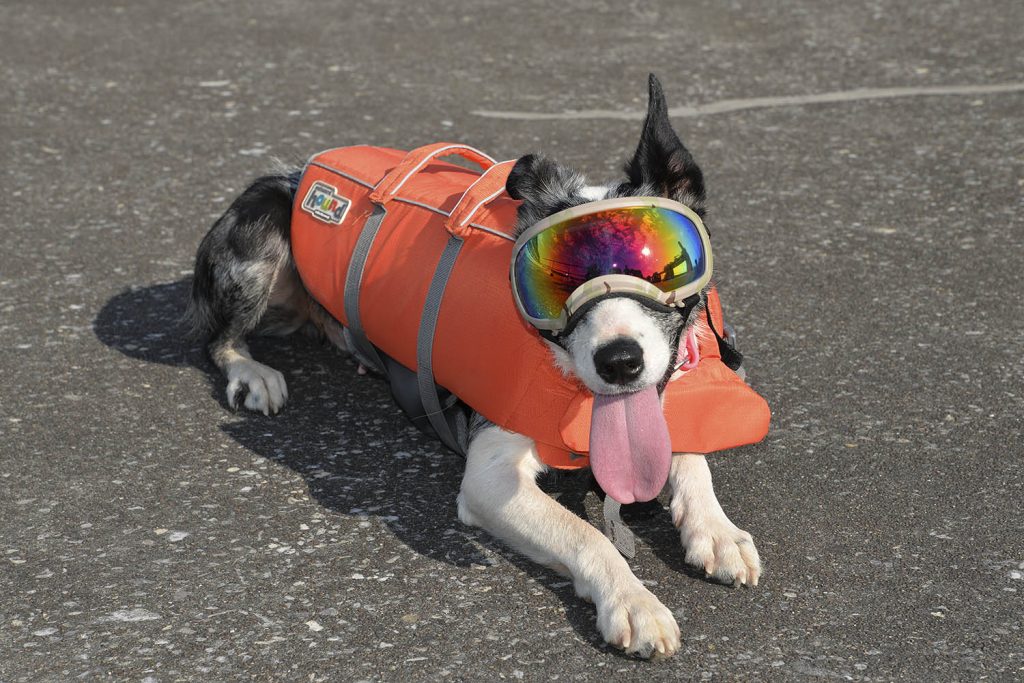For the second time ever, the Corps of Engineers has employed a well-trained dog to deter nuisance birds from an inland lock and dam system. Breeze, a blue merle, smooth-coated border collie, was delivered to Cannelton Locks and Dam in Cannelton, Ind., September 18 by Rebecca Gibson from Flyaway Geese, an organization providing professional bird management by dog deterrence.
Breeze, who will be 2 years old in January, began staying all night at the lock last week. “It gives Breeze the chance to work with other lock personnel,” said Larry Dunning, Cannelton Locks and Dam lockmaster. “For the first couple weeks, it was recommended by Flyaway Geese, that Breeze spend nights at home with [me]. The intent was to help Breeze gain trust with the lockmaster and learn to follow commands from me before she was trained with other personnel.”
She started her training at 8 months old on a farm in North Carolina. She recently gave birth to her first litter of puppies.

“Breeze is a fully-trained bird control dog, so we are excited for what she is going to do out here,” Gibson said. “It should be a lot of fun for these guys and a ton of fun for her.”
When Breeze isn’t training or working during the day, she has a kennel in the break room at the lock, with her bed and toys inside of it.
The team will be assessing Breeze for the next three months to determine her effectiveness of deterring vultures that are eating away the expansion joints on the dam. The vultures are most problematic for the facility when drift accumulates on the dam, according to the Louisville Engineer District.
“As soon as we replace the expansion joints, the vultures tear them right back out,” said Dunning. “We are hoping that if the dog works and the vultures stay away, we will be able to replace all the expansion joints next summer.”
Dunning said that if all goes to plan, Breeze will be worked daily. “She goes up on the dam and around the locks different times of the day,” he said. “This allows for the element of surprise with the birds by her not having a set routine. She works hard chasing all the pigeons and vultures away. She runs them until they completely go away and won’t rest until they are gone. She is well trained, but of course with anything there is a learning curve to go through. It’s been amazing to watch her work.”
In addition to the nuisance vultures, pigeons and geese continuously cover the project site with their defecation, causing health hazards to the employees and visitors. Breeze has been trained to deter those birds as well.
On May 23, Danielle D’Amato, Engineer Research and Development Center research biologist, came to consult, advise staff and assess the damage and hazards posed by birds. D’Amato visited field sites to determine suitability for using and housing a dog, and educated the lockmasters and employees on the benefits of using dogs to deter birds. It was concluded that several species of birds have created an unhealthy and unsightly working environment and have damaged Corps facilities.
Nuisance bird behavior is costly to the projects, consuming funding and labor hours, and using dogs like the Corps’ first dam dog, Ellie, to deter birds has already proved successful at projects in the Tulsa and Chicago districts.
Dogs are natural predators whose presence can be a deterrent to birds, said the Corps. The dogs are trained to actively deter birds by patrolling specific areas of a project. Using a dog can be substantially less costly than conventional deterrence methods like baiting or trapping.
“This will be the second dog that the Corps of Engineers has,” said Todd Kimery Louisville District assistant operations manager. “Right now, the initial thought is that we would split her time between two locks and dams since the facilities are close in distance.”
Other locks and dams with bird issues are John T. Myers Locks and Dam in Mt. Vernon, Ind.; Markland Locks and Dam in Warsaw, Ky.; and McAlpine Locks and Dam in Louisville, Ky.





